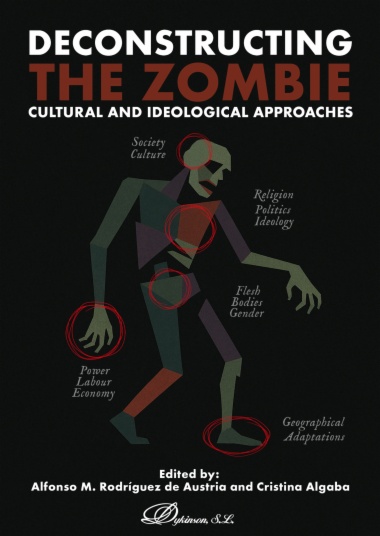Since the COVID-19 pandemic, we have not experienced a moment of calm. A spectre haunts the world: the spectre of permanent crisis. Indeed, the forthcoming social, economic, and political conditions will favour the zombies, ensuring their continued presence in our cultural agenda. Throughout several literary, cinematographic, serial fiction and video game cultural productions, this character has served as a symbolic representation of the individual at different times in history. Whether by harshly denouncing the alienated or passive attitudes that human beings tend to adopt in certain situations, urging them to rebel against the system, or by portraying the zombie as a victim of human racial, gender, social, or class prejudices, and of their desire to exert power over their own and other species.This book covers a wide range of topics concerning its universe, offering a complete study divided into six significant areas:1. Power, Labour, and Economy2. Ethics, Religion, and Society3. Flesh, Bodies, and Gender4. Politics and Ideology5. Geographical Adaptations6. Social and Cultural Manifestations
- Cover
- Title page
- Copyright page
- Index
- Introduction, Alfonso M. Rodriguez de Austria and Cristina Algaba
- Part I. Power, Labour & Economy
- Chapter 1. Fear the fetish: Media, Monster capitalism and the meta-myth of zombies marco briziarelli and christina blankenship
- 1. Introduction
- 2. Zombies as a triadic ideological sign
- 3. Conclusions: Fearing the crisis
- 4. References
- Chapter 2. Zombie power. Between slavery and rebellion, victor Hernandez-Santaolalla
- 1. Introduction
- 2. The imperialist dream and the slave’s nightmar
- 3. Consumerism, Social violence and nostalgia
- 4. The return of the slave
- 5. Conclusions
- 6. References
- Chapter 3. Izombie. Zombies as comedic victims of the neoliberal system, Irene Raya Bravo and Pedro J. Garcia
- 1. Introduction: Framing izombie in its discursive context
- 2. Izombie and other zombie products in humorous contexts: A brief audiovisual review
- 3. Humour and capitalism in izombie
- 4. Conclusions
- 5. References
- Chapter 4. Capitalizm: An ideological odyssey, Nikola Mladenovic
- 1. Introduction
- 2. Romero’s revoluzion
- 3. The vital walk
- 4. Everyday capitalizm
- 5. References
- Part II. Ethics, Religion & Society
- Chapter 5. Celluloid zombies as a reflection of concerns over science in fifties america, Marta Pinol-Lloret
- 1. Introduction: Fear and longing in troubled times
- 2. Zombies origins: Atomic birth
- 3. Zombies origins: Created by aliens
- 4. Conclusions
- 5. References
- Chapter 6. The process of personal transformation of the figure of the zombie-killer hero through asian cinema. The case of i am a hero, Jesus Conde-Jimenez and Salvador Reyes-de Cozar
- 1. Introduction
- 2. Starting point: Hideo suzuki, With h for hero
- 3. The turning point: Hiromi, With h for hideo
- 4. The last stop: Fuji royal outlet park
- 5. Conclusions
- 6. References
- Chapter 7. Reunited against masses: Individuality and collectivity in the walking dead, Asli favaro
- 1. Introduction
- 2. Individuals as not-yet-living-dead
- 3. The emergence of communities under the leadership
- 4. The change of communities seized by external threats
- 5. Conclusions
- 6. References
- Chapter 8. The god of the apocalypse: Narratives about the divinity in the walking dead, Eduar barbosa caro and johanna ramirez suavita
- 1. Introduction: Consuming the zombie
- 2. Religious elements in the zombie world
- 3. The attributes of the divinity
- 4. God in the walking dead
- 5. Who is the god of the apocalypse?
- 6. Some final bites
- 7. References
- Chapter 9. The living dead and their relationship with violence in spanish cinema, Sara Gonzalez-Fernandez
- 1. Introduction: Zombies and their violent nature
- 2. The figure of the zombie as an aggressor in spanish cinema
- 3. Conclusions
- 4. References
- Chapter 10.“Alive or dead, the truth won’t rest": Politics and poetics of media revolutions under the zombie apocalypse in mira grant's newflesh trilogy, Caroline Duvezin-Caubet
- 1. Introduction
- 2. The blogosphere
- 3. Freedom of information?
- 4. Puns and poems
- 5. Conclusions: Rise up
- 6. References
- Part III. Flesh, Bodies & Gender
- Chapter 11. Bodies beyond the grave: Gender, body and disgust in female zombies, Itxaso del Castillo
- 1. Introduction
- 2. I walked with a zombie: The disoriented woman,The woman without a home
- 3. Zombie strippers: When flesh admits its nature
- 4. Conclusions
- 5. References
- Chapter 12. The horrors of the flesh. The zombified body as effective archive in in the flesh (2013.2014), Nadine Dannenberg
- 1. Introduction
- 2. (Zombified) Bodies-as-archives
- 3. Traces (in) in the flesh
- 4. Zombified bodies as affective queer archives
- 5. References
- Chapter 13. Animals Vs. Zombies: Representations and roles of the animal kingdom in zombie fiction, Nicholas Dion
- 1. Introduction
- 2. 'Do animals have souls"
- 3. “Maybe they don’t like pig'
- 4. "They know we mean them no harm"
- 5. Conclusions
- 6. References
- Chapter 14. Agency of the flesh: Humanness, obscenity, and death in bruce labruce's otto; or, up with dead people, Ari P. Büyüktas
- 1. Introduction
- 2. Human/ness and zombie/ness
- 3. Porn zombies
- 4. Conclusions
- 5. References
- Part IV. Politics & Ideology
- Chapter 15. The walking dead, The alt-right and the rise of libertarian fantasies (and donald trump�fs politics), Alfonso M. Rodriguez de Austria
- 1. Introduction
- 2. The alt-right
- 3. References
- Chapter 16. The monster of empathy, Georg Malcovati
- 1. Introduction
- 2. The emotionless zombie
- 3. The empathic zombie
- 4. Conclusions
- 5. References
- Chapter 17. The last of us: American individualism in survival horror, Jose Maria Calvo Moreno and Olmo Castrillo Cano
- 1. Introduction
- 2. Context: Rhetorical devices and ludonarrative in the last of us
- 3. "It was him or me". The line in the last of us reflect the individual's demo
- 4. Conclusions
- 5. References
- Chapter 18. “You have to decide what side you’re on”: Examining izombie’s seasons three and four as contemporary political commentary
- 1. Introduction
- 2. Exploitation: The mcdonoughs, and religion
- 3. Resistance: Liv moore goes renegade
- 4. Collusion: Major lillywhite soldiers on
- 5. Conclusions
- 6. References
- Part V. Geographical adaptations
- Chapter 19. Can a zombie apocalypse transform japanese society? critical analysis of the zombie�fs cultural significance in japanese cinema, Francisco Javier Lopez Rodriguez
- 1. Introduction
- 2. Japanese zombie cinema
- 3. Final remarks
- 4. References
- Chapter 20. Juan of the dead: The scenario and socio-political criticism in zombie movies, Rafael Menendez Fernandez. and Begona Gutierrez San Miguel
- 1. Introduction: Film genre and socio-political criticism
- 2. The film
- 3. The context: The zombies, The special period and "the thing that came later"
- 4. Conclusions
- 5. References
- Chapter 21. A socio-cultural perspective on the representation of zombies in nollywood: A study of c. j. obasi's ojuju and banji oyemaja's outbreak 2020, Floribert Endong
- 1. Introduction
- 2. Profiling the living dead: Western vs. African zombies
- 3. The zombie genre in the nollywood film industry
- 4. Representation of zombies in c. j. obasi’s ojuju and banji oyemaja’s outbreak 2020
- 5. Conclusions
- 6. References
- Chapter 22. “When the dead come out of their graves, The living will be their blood…”. Zombie italian style, Ludovico Longhi
- 1. Introduction
- 2. Alarm across the globe: The wind carries the disease in europe
- 3. “When there is no more room in hell”: The irony of fulci
- 4. Conclusions: “Rome, September 5: We saw zombie ii, science-fiction horror film, Ghastly; repulsive trash”
- 5. References
- Part VI. Social & cultural manifestations
- Chapter 23. The zombie: A metaphor to live (and die) by? a folk model of familiar monsters, Lina Rahm and Jorgen Behrendtz
- 1. Introduction
- 2. The pop-cultural zombie
- 3. Academic analyses of the zombie
- 4. Premediation and folk models
- 5. A folk model of familiar monsters
- 6. References
- Chapter 24. Tech-comm versus zombies: A post-apocalyptic pedagogy, Samuel J. Fuller
- 1. Introduction
- 2. Ethical paradox
- 3. Topics
- 4. Conclusions
- 5. References
- Chapter 25. Zombie reconstruction in contemporary society: The zombie mermaid, Martine Mussies
- 1. Horror mermaids
- 2. The ningyo
- 3. Modern media
- 4. Fanfiction
- 5. Children's and young adult book
- 6. Conclusions
- 7. References
- Chapter 26. Zombies and music, James Wierzbicki
- 1. Introduction
- 2. Music in zombieland
- 3. Zombies in musicland
- 4. Music zombies
- 5. Conclusions
- 6. References
- Chapter 27. The march of the neo-baroque zombie: From human to hunger, Aaron rodriguez, Serrano, Teresa Sorolla Romero, and Shaila Garcia Catalan
- 1. Introduction
- 2. A howl of pain: From memento mori to the zombie
- 3. Laughter and action in the face of the void: Function
- 4. Conclusions: The living dead reflect the inhumanity of pleasure
- 5. References
- Chapter 28. Conclusion. Zombie universes: (Pre-)configurations of a (post-)pandemic world, Cristina Algaba and Alfonso M. Rodriguez de Austria
- 1. Introduction
- 2. A taxonomy of the undead: The many disguises of the zombie
- 3. Conclusions
- 4. References

